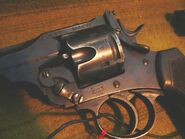The Webley Revolver, was, in various marks, the standard issue service pistol for the armed forces of the United Kingdom, the British Empire and the Commonwealth from 1887 until 1963.
The Webley is a top-break revolver with automatic extraction. Therefore, breaking the revolver open for reloading also operates the extractor, which removes the spent cartridges from the cylinder. The Webley Mk I service revolver was adopted in 1887. A later version, the Mk IV, was used during the Second Boer War. However, the Mk VI, first used in 1915 during World War I, is possibly the most famous model.
Firing the large .455 Webley cartridge, Webley service revolvers are among the most powerful top-break revolvers ever produced. The .455 caliber Webley is no longer used by militaries, the .38/200 Webley Mk IV variant is still used by the police forces of several countries. [1]
History[]
The British Company Webley & Scott produced many revolvers from the mid 19th to late 20th centuries. As early as 1853, P. Webley and J. Webley began production of their patented single action cap and ball revolvers. Later, under the trade name of P. Webley and Son, a .44cal rim-fire solid frame revolver as well as licensed copies of the Smith & Wesson Tip up break action revolver were manufactured. The hinged frame, center-fire revolvers for which Webley is best known for began development in the early 1870s with the Webley-Pryse in 1877 and the Webley-Kaufman in 1881.
In 1887, the British Army was searching for a revolver to replace the unsuccessful Enfield Mk I and Mk II revolvers. Webley & Scott, who were already notable makers of quality guns and had sold many pistols on a commercial basis to officers and civilians alike, tendered the .455 Webley Self-Extracting Revolver for trials. The military was suitably impressed with the Webley, and it was adopted in November 1887 as the "Pistol, Webley, Mk I".[2] The initial contract called for 10,000 Webley revolvers, at a price of £3/1/1 each, with at least 2,000 to be supplied within eight months.[3]
The Webley revolver went through a number of changed, culminating in the Mk VI, which was produced between 1915 and 1923. The large .455 revolvers were retired in 1947, although the Webley Mk IV .38/200 remained in service until 1963. Commercial versions of all Webley service revolvers were sold on the commercial market, along with a number of similar designs that were not officially adopted for service, but were nonetheless purchased privately by officers.
Operational History[]
Boer War[]
The Webley Mk IV was introduced in 1899. It quickly became known as the "Boer War Model"[4], on account of the large quantity of offices whp purchased it on their way to South Africa. It served alongside a number of other handguns, including the Mauser C96, earlier Beaumont-Adams cartridge revolvers and other top-break revolvers.
World War I[]
The standard issue pistol at the beginning of the war was the Webley Mk V, adopted in 1913. However, there were considerably more Mk IV s in service in 1914, as the initial order for 20,000 Mk V revolvers had not been completed at the outbreak. The Webley Mk VI was adopted as the standard sidearm for all British and Commonwealth troops on 24 May 1915.[5] It remained so for the duration of the war, being issued to officers, airman, naval crews, boarding parties, trench raiders, machine gun teams and tank crews. The Mk VI proved to be a very reliable and hardy weapon, suitable for the mud and adverse conditions of trench warfare, and several accessories were developed for the Mk VI, including a bayonet, speedloader devices, and a stock allowing for the revolver to be converted into a carbine.
World War II
The official service pistol for the British military during the Second World War was the Enfield No. 2 Mk I .38/200 calibre revolver, but owing to a critical shortage of handguns, a number of other weapons were also adopted to alleviate the shortage. As a result, both the Webley Mk IV in .38/200 and the Webley Mk Vi in .455 calibre were issued to personnel during World War II.
Users[]
- Canada
- Commonwealth of Nations
- Hong Kong (retired)
- India
- Israel
- Luxembourg
- Philippines
- Singapore (retired)
- United Kingdom
Gallery[]
References[]
- ↑ Historic firearm of the month, July 1999, Cruffler.com. Retrieved on 2006-12-02
- ↑ § 6075, List of Changes in British War Material (hereafter referred to as "LoC"), H.M. Stationer's Office, periodical
- ↑ Skennerton, Ian D., Small Arms Identification Series No. 9: .455 Pistol, Revolver No. 1 Mk VI, p. 6, Arms & Militaria Press, 1997.
- ↑ Maze, Robert J., Howdah to High Power, p. 44, Excalibur Publications, 2002.
- ↑ Dowell, William Chipchase, The Webley Story, p. 115, Commonwealth Heritage Foundation, 1987.






